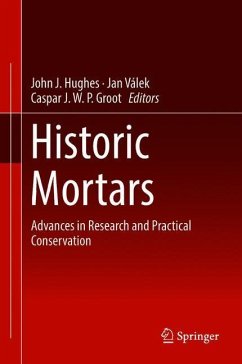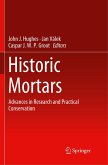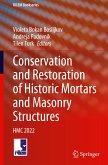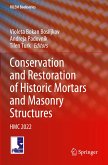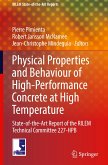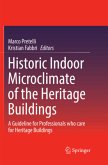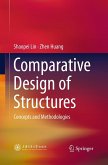Historic Mortars
Advances in Research and Practical Conservation
Herausgegeben:Hughes, John J.; Válek, Jan; Groot, Caspar J. W. P.
Historic Mortars
Advances in Research and Practical Conservation
Herausgegeben:Hughes, John J.; Válek, Jan; Groot, Caspar J. W. P.
- Gebundenes Buch
- Merkliste
- Auf die Merkliste
- Bewerten Bewerten
- Teilen
- Produkt teilen
- Produkterinnerung
- Produkterinnerung
This book presents a state of the art in mortar characterisation, experimentation with and applications of new mortars for conservation and repair of historic buildings. This volume includes the following topics: characterisation of historic mortars (methods, interpretation, application of results), development of new materials for conservation (compatibility, durability, mix designs), the history of mortar technology and fundamental experimental studies of material properties. The papers have been selected from those presented at the 3 rd Historic Mortars Conference, held in Glasgow,…mehr
Andere Kunden interessierten sich auch für
![Historic Mortars Historic Mortars]() Historic Mortars112,99 €
Historic Mortars112,99 €![Conservation and Restoration of Historic Mortars and Masonry Structures Conservation and Restoration of Historic Mortars and Masonry Structures]() Conservation and Restoration of Historic Mortars and Masonry Structures149,99 €
Conservation and Restoration of Historic Mortars and Masonry Structures149,99 €![Conservation and Restoration of Historic Mortars and Masonry Structures Conservation and Restoration of Historic Mortars and Masonry Structures]() Conservation and Restoration of Historic Mortars and Masonry Structures149,99 €
Conservation and Restoration of Historic Mortars and Masonry Structures149,99 €![Physical Properties and Behaviour of High-Performance Concrete at High Temperature Physical Properties and Behaviour of High-Performance Concrete at High Temperature]() Physical Properties and Behaviour of High-Performance Concrete at High Temperature75,99 €
Physical Properties and Behaviour of High-Performance Concrete at High Temperature75,99 €![Historic Indoor Microclimate of the Heritage Buildings Historic Indoor Microclimate of the Heritage Buildings]() Historic Indoor Microclimate of the Heritage Buildings104,99 €
Historic Indoor Microclimate of the Heritage Buildings104,99 €![Bridges Bridges]() Baidar BakhtBridges104,99 €
Baidar BakhtBridges104,99 €![Comparative Design of Structures Comparative Design of Structures]() Shaopei LinComparative Design of Structures91,99 €
Shaopei LinComparative Design of Structures91,99 €-
-
-
This book presents a state of the art in mortar characterisation, experimentation with and applications of new mortars for conservation and repair of historic buildings. This volume includes the following topics: characterisation of historic mortars (methods, interpretation, application of results), development of new materials for conservation (compatibility, durability, mix designs), the history of mortar technology and fundamental experimental studies of material properties. The papers have been selected from those presented at the 3 rd Historic Mortars Conference, held in Glasgow, Scotland, September 11-14 th 2013. All the papers here underwent a two stage peer review process, for the conference and again for this volume. In some cases this has resulted in a revision and updating of content.
Produktdetails
- Produktdetails
- Verlag: Springer / Springer International Publishing / Springer, Berlin
- Artikelnr. des Verlages: 978-3-319-91604-0
- 1st ed. 2019
- Seitenzahl: 348
- Erscheinungstermin: 18. Juli 2018
- Englisch
- Abmessung: 241mm x 160mm x 25mm
- Gewicht: 676g
- ISBN-13: 9783319916040
- ISBN-10: 3319916041
- Artikelnr.: 52379195
- Herstellerkennzeichnung
- Springer Nature c/o IBS
- Benzstrasse 21
- 48619 Heek
- Tanja.Keller@springer.com
- Verlag: Springer / Springer International Publishing / Springer, Berlin
- Artikelnr. des Verlages: 978-3-319-91604-0
- 1st ed. 2019
- Seitenzahl: 348
- Erscheinungstermin: 18. Juli 2018
- Englisch
- Abmessung: 241mm x 160mm x 25mm
- Gewicht: 676g
- ISBN-13: 9783319916040
- ISBN-10: 3319916041
- Artikelnr.: 52379195
- Herstellerkennzeichnung
- Springer Nature c/o IBS
- Benzstrasse 21
- 48619 Heek
- Tanja.Keller@springer.com
Characterisation of historic materials.- How to identify a natural cement: case study of the Vassy Church, France, by M. Bouichou, E. Marie-Victoire, A.Texier and T. Blondiaux.- Methods of microscopy to identify and characterise hydraulic binders in historic mortars - a methodological approach, by J. Weber, T. Köberle and F. Pintér.- Composition and application of cimorné finish: an interwar cement render decorated with coloured opalescent glass granules, by Liesbeth Dekeyser, Laurent Fontaine, Ann Verdonck and Hilde De Clercq.- Historic renders and their weathering at the temple Wat Mahathat, UNESCO World Heritage Site of Ayutthaya, Thailand, by H. Siedel, E. Wendler and B. Ullrich.- From dry-stone to shell-lime bound: High Medieval contrasts in masonry technique at Skellig Michael, High Island and North Rona, by M. Thacker.- Medieval Mortars and the Gothic Revival: The Cosmati Pavement at Westminster Abbey, by Ruth Siddall.- Terranova, a popular stone imitation cladding: Strategies and techniques for restoration, by Yves Govaerts, Ann Verdonck, Wendy Meulebroeck and Michael de Bouw.- Characterisation of historic mortars for conservation diagnosis, by P. Hauková, D. Frankeová and Z. Slízková.- Content and topography of salts in historic mortars, by Ioanna Papayianni, Maria Stefanidou, Vasiliki Pachta and Stavroula Konopisi.- New materials' development for conservation.- Portland cement-lime mortars for conservation, by S. Pavia and O. Brennan.- Choosing mortar compositions for repointing of historic masonry under severe environmental conditions, by Caspar JWP Groot and Jos TM Gunneweg.- High-performance repair mortars for application in severe weathering environments: frost resistance assessment, by D. Krivánková, C. P. Nunes, Z. Slízková, D. Frankeová, K. Niedoba.- Compatibility assessment for repair mortars: an optimized cement-based mix for Tuffeau de Lincent, by A. Isebaert, L. Van Parys, V. Cnudde, T. De Kock and J.M. Baele.- Natural hydraulic lime mortars: influence of the aggregates, by P. Faria and V. Silva.- The influence of calcitic filler in hydraulic lime mortars for use in high temperature & high humidity climatic conditions: A preliminary investigation, by Alan M Forster, Nadia Razali, Phil Banfill, Ewan Szadurski and Clare Torney.- Viability of ceramic residues in lime-based mortars, by G.Matias, P. Faria and I.Torres.- Effects of various chemical agents on mechanical characteristics of weak lime mortar, by Z. Slízková, M. Drdácký.- Artisanal lime coatings and their influence on moisture transport during drying, by T. Diaz Gonçalves and V. Brito.- Historic Contexts and Experimental Developments.- The development of binders and mortars in Sweden, by J.E. Lindqvist and S. Johansson.- Development of a small-scale lime kiln and experimental assessment of the produced quicklime, by J. Válek, O. Skruzná, V. Petránová, D. Frankeová and J. Jirousek.- Lime burning tradition in a field kiln of the Jämtland model in Sweden, byK. Balksten, C. Persson and J. Eriksson.- The compatibility of earth-based repair mortars with rammed earth substrates, by M. I. Gomes, T. Diaz Gonçalves and P. Faria.- Heat and moisture simulations of repair mortars: benchmark experiments and practical cases in conservation, by Roel Hendrickx and Hilde De Clercq.
Characterisation of historic materials.- How to identify a natural cement: case study of the Vassy Church, France, by M. Bouichou, E. Marie-Victoire, A.Texier and T. Blondiaux.- Methods of microscopy to identify and characterise hydraulic binders in historic mortars - a methodological approach, by J. Weber, T. Köberle and F. Pintér.- Composition and application of cimorné finish: an interwar cement render decorated with coloured opalescent glass granules, by Liesbeth Dekeyser, Laurent Fontaine, Ann Verdonck and Hilde De Clercq.- Historic renders and their weathering at the temple Wat Mahathat, UNESCO World Heritage Site of Ayutthaya, Thailand, by H. Siedel, E. Wendler and B. Ullrich.- From dry-stone to shell-lime bound: High Medieval contrasts in masonry technique at Skellig Michael, High Island and North Rona, by M. Thacker.- Medieval Mortars and the Gothic Revival: The Cosmati Pavement at Westminster Abbey, by Ruth Siddall.- Terranova, a popular stone imitation cladding: Strategies and techniques for restoration, by Yves Govaerts, Ann Verdonck, Wendy Meulebroeck and Michael de Bouw.- Characterisation of historic mortars for conservation diagnosis, by P. Hauková, D. Frankeová and Z. Slízková.- Content and topography of salts in historic mortars, by Ioanna Papayianni, Maria Stefanidou, Vasiliki Pachta and Stavroula Konopisi.- New materials' development for conservation.- Portland cement-lime mortars for conservation, by S. Pavia and O. Brennan.- Choosing mortar compositions for repointing of historic masonry under severe environmental conditions, by Caspar JWP Groot and Jos TM Gunneweg.- High-performance repair mortars for application in severe weathering environments: frost resistance assessment, by D. Krivánková, C. P. Nunes, Z. Slízková, D. Frankeová, K. Niedoba.- Compatibility assessment for repair mortars: an optimized cement-based mix for Tuffeau de Lincent, by A. Isebaert, L. Van Parys, V. Cnudde, T. De Kock and J.M. Baele.- Natural hydraulic lime mortars: influence of the aggregates, by P. Faria and V. Silva.- The influence of calcitic filler in hydraulic lime mortars for use in high temperature & high humidity climatic conditions: A preliminary investigation, by Alan M Forster, Nadia Razali, Phil Banfill, Ewan Szadurski and Clare Torney.- Viability of ceramic residues in lime-based mortars, by G.Matias, P. Faria and I.Torres.- Effects of various chemical agents on mechanical characteristics of weak lime mortar, by Z. Slízková, M. Drdácký.- Artisanal lime coatings and their influence on moisture transport during drying, by T. Diaz Gonçalves and V. Brito.- Historic Contexts and Experimental Developments.- The development of binders and mortars in Sweden, by J.E. Lindqvist and S. Johansson.- Development of a small-scale lime kiln and experimental assessment of the produced quicklime, by J. Válek, O. Skruzná, V. Petránová, D. Frankeová and J. Jirousek.- Lime burning tradition in a field kiln of the Jämtland model in Sweden, byK. Balksten, C. Persson and J. Eriksson.- The compatibility of earth-based repair mortars with rammed earth substrates, by M. I. Gomes, T. Diaz Gonçalves and P. Faria.- Heat and moisture simulations of repair mortars: benchmark experiments and practical cases in conservation, by Roel Hendrickx and Hilde De Clercq.

